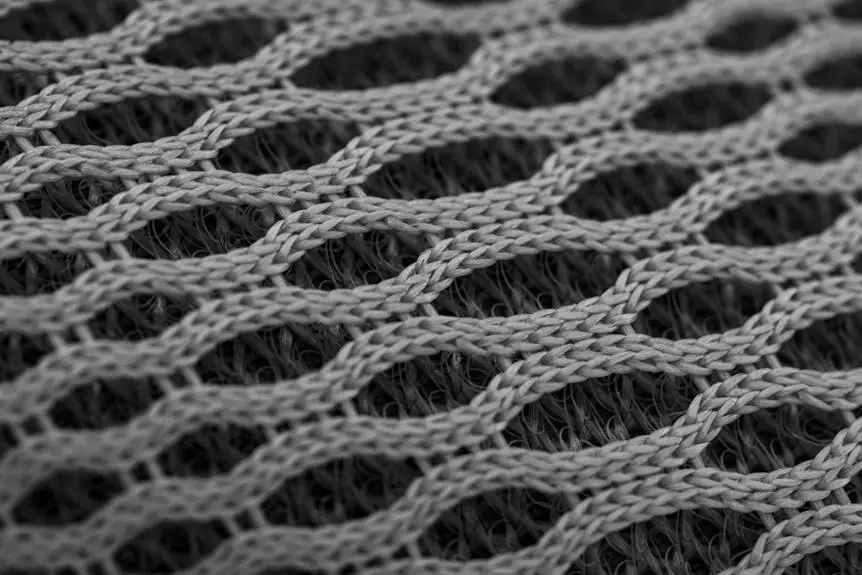When you're stiffening fabric, it's easy to overlook some critical details that can make or break your project. You might find yourself choosing the wrong stiffener, which can lead to a disappointing texture, or neglecting the specific type of fabric you're using, resulting in uneven results. It's crucial to apply the stiffener evenly and remember that pre-washing your fabric isn't just a suggestion. Each step you take matters, and missing even one could lead to frustrating outcomes. So, what are the key mistakes you should watch out for to ensure success?
Table of Contents
Key Takeaways
- Always choose the right stiffener based on your fabric type and project requirements to ensure proper support and drape.
- Pre-wash fabrics to remove oils and dirt, allowing for better adhesion of the stiffening agent and avoiding color bleeding.
- Apply stiffener evenly using consistent brush strokes and proper dilution ratios for a polished and uniform finish.
- Allow sufficient drying time in a well-ventilated area to ensure the stiffener sets properly and enhances durability.
Choosing the Wrong Stiffener
Choosing the wrong stiffener can lead to disappointing results in your fabric projects. When you pick a stiffener that doesn't match your fabric's weight and texture, you might end up with a project that looks floppy or overly rigid.
For instance, using a heavy starch on delicate fabrics can weigh them down, ruining the drape and flow you aimed for. On the other hand, a lightweight stiffener mightn't provide the support you need for structured items like bags or home decor.
To avoid this mistake, always consider the type of project you're working on. If you're making a structured item, opt for a stiffer product, whereas for softer, more fluid designs, a lighter option might work best.
Don't forget to test the stiffener on a scrap piece of your fabric first. This small step can save you from potential disasters down the line.
Ignoring Fabric Type
Overlooking the specific characteristics of your fabric can lead to ineffective stiffening results. Each fabric has its own unique properties, such as weight, texture, and absorbency, which play a significant role in how well it will respond to stiffening agents. For instance, lightweight fabrics like chiffon may not hold their shape as well as heavier materials like canvas. If you ignore these differences, you might end up with a project that looks limp or overly rigid.
When choosing a stiffener, consider the fabric type. Natural fibers like cotton and linen absorb stiffeners differently than synthetic fibers. You'll find that some fabrics require more product to achieve the desired stiffness, while others may need less. Also, be aware that certain stiffeners can alter the fabric's color or texture, which mightn't be your intention.
Testing a small piece of fabric before committing to the entire project can save you time and frustration. By acknowledging the unique attributes of your fabric, you can select the right stiffening method and achieve the results you want. Don't skip this crucial step; it'll make all the difference in your finished piece.
Uneven Application Techniques
When you're stiffening fabric, uneven application techniques can lead to disappointing results.
You might notice issues like inconsistent brush strokes, improper dilution ratios, or overlapping areas that can ruin your project.
Let's explore how these mistakes can impact your fabric stiffness and how to avoid them.
Inconsistent Brush Strokes
Inconsistent brush strokes can lead to uneven fabric stiffening, resulting in a less polished final product. When you apply your stiffening solution, it's crucial to maintain a steady hand and uniform pressure. If you rush or switch up your technique mid-way, you risk creating patches that are overly stiff or remain floppy.
To avoid this mistake, take your time. Start at one edge and work your way across, using long, even strokes. If you notice any inconsistencies while applying, don't hesitate to go back and correct them. Remember, less is often more—don't overload your brush with the solution, as this can cause drips and uneven distribution.
Additionally, choose the right brush for the job. A flat, wide brush provides better coverage and allows for smoother strokes compared to a smaller, round brush.
Improper Dilution Ratio
Getting the dilution ratio wrong can significantly impact how evenly your fabric stiffening solution applies, leading to unsightly patches. When the concentration isn't just right, you might find some areas are overly stiff while others remain floppy. It's crucial to follow the manufacturer's guidelines for the perfect balance between stiffening agent and water.
To achieve a consistent application, measure your ingredients carefully. Use a precise measuring cup or a syringe to ensure you're mixing the right amounts. If your solution is too diluted, it won't provide the desired stiffness; if it's too concentrated, you risk creating a brittle finish that cracks easily.
When you apply the solution, keep in mind that even your application technique can affect the outcome. A consistent dilution ratio combined with smooth, even strokes will give you a more uniform finish.
Remember to test your mixture on a scrap piece of fabric before tackling your main project. This way, you can adjust the dilution as needed and avoid any surprises down the line.
With careful attention to your dilution ratio, you'll achieve a professional-looking result every time.
Overlapping Application Areas
Applying your fabric stiffening solution with uneven techniques can lead to overlapping application areas that create noticeable inconsistencies in stiffness. When you apply the solution too heavily in one spot and too lightly in another, you're setting yourself up for patches that feel different when touched or seen. This unevenness can ruin the aesthetic appeal of your project.
To avoid this, make sure you use a consistent method across the entire fabric. Whether you're brushing, spraying, or dipping, aim for uniform strokes and an even distribution. If you're spraying, keep the nozzle at a consistent distance from the fabric. If you're brushing, use the same pressure and speed throughout the application.
Additionally, consider working in smaller sections. This way, you can focus on applying the stiffening solution evenly, reducing the chance of overlapping. After applying, check for areas that look different, and address them immediately.
Skipping Pre-Washing Fabric
If you skip pre-washing your fabric, you're setting yourself up for issues down the line.
Dirt, oils, and sizing can interfere with the stiffening process, leading to uneven results.
Making sure your fabric is clean beforehand ensures better adhesion and a smoother finish.
Importance of Fabric Cleanliness
Have you ever wondered how skipping the pre-washing of fabric can affect your stiffening project? Cleanliness is crucial in ensuring your fabric stiffening efforts are successful. When you skip this step, you're likely to encounter several issues that can hinder your project.
Contaminants: Dirt, oils, or chemicals from the manufacturing process can interfere with the stiffening agent, affecting its adhesion.
Shrinkage: Fabrics can shrink after the stiffening process if they haven't been washed first, leading to an undesired final appearance.
Color Bleeding: Unwashed fabrics may bleed dye, potentially ruining your stiffening result or other materials used in the project.
Stiffening Consistency: A clean fabric allows for even application of the stiffening solution, ensuring consistent results.
Longevity: Pre-washing helps remove any residues that could degrade the fabric over time, enhancing the durability of your project.
Effects on Stiffening Process
Skipping the pre-washing step can lead to a range of complications during the stiffening process that undermine your project's success. When you don't wash your fabric, you may leave behind residues, dirt, or even sizing agents that manufacturers apply. These substances can interfere with the stiffening solution, preventing it from penetrating the fibers effectively. As a result, your fabric mightn't stiffen as expected, leaving you with a flimsy, unsatisfactory result.
Additionally, unwashed fabric can shrink or distort when you apply heat or moisture during the stiffening process. This can cause uneven stiffness, creating an unprofessional appearance. You might also notice that colors bleed or fade if you skip washing, which can ruin your project's aesthetic.
Moreover, if you plan to wash your finished project later, skipping the pre-wash can lead to further complications. The stiffening agent may react with soap or water, causing undesirable changes in texture or stiffness.
To avoid these issues, always pre-wash your fabric. It sets a solid foundation for the stiffening process, ensuring your final product meets your expectations.
Not Allowing Sufficient Drying Time
Rushing the drying process can lead to a stiffened fabric that's uneven and prone to damage. You might think that speeding things up will save you time, but it often results in a disappointing final product. When you don't allow sufficient drying time, the stiffener doesn't set properly, which can compromise the fabric's texture and durability.
Here are some tips to ensure your fabric dries correctly:
- Choose the right environment: Find a dry, warm area with good air circulation.
- Avoid direct sunlight: While it seems like a good idea, it can cause uneven drying and fading.
- Use fans: If you're in a hurry, strategically placed fans can help enhance airflow.
- Check for thickness: Thicker layers take longer to dry, so allow extra time for those pieces.
Miscalculating Stiffener Dilution
How can miscalculating the dilution of your stiffener affect the final outcome of your project?
When you don't get the proportions right, you risk either an overly stiff fabric or one that lacks the desired rigidity. If you use too much stiffener, the fabric can become brittle, cracking or losing its shape. On the other hand, too little stiffener results in a limp and ineffective structure that doesn't hold its form.
To avoid this mistake, always measure your stiffener and solvent accurately. Use a scale for precise measurements, and keep a record of your successful mixtures for future reference. Remember, different fabrics may require different dilutions, so test on a scrap piece before committing to your main project.
Also, consider the type of stiffener you're using; some are more concentrated than others. Don't just follow a one-size-fits-all ratio; adjust based on your specific needs.
Frequently Asked Questions
Can I Mix Different Types of Stiffeners Together?
Yes, you can mix different types of stiffeners, but it's essential to test a small sample first. Combining them might create unique effects, but you might also risk compromising the fabric's integrity or finish.
How Do I Fix Overly Stiffened Fabric?
To fix overly stiffened fabric, soak it in warm water to soften. Gently knead and rinse it, then air dry. You might need to repeat this process until you achieve your desired softness.
Are There Eco-Friendly Stiffener Options Available?
Yes, there are eco-friendly stiffener options available! You can use cornstarch, sugar water, or natural fabric starch made from plant materials. These alternatives provide stiffness while being safer for the environment and easier to handle.
Can I Use Fabric Stiffener on Clothing?
Yes, you can use fabric stiffener on clothing, but it's essential to choose the right type. Test on a small area first to ensure it doesn't affect the fabric's texture or feel negatively.
What Tools Are Best for Applying Fabric Stiffener Evenly?
To apply fabric stiffener evenly, use a spray bottle for fine mist coverage, a brush for precision, or a sponge for larger areas. Each tool helps you achieve consistent results without over-saturating your fabric.
- How Does Ring Spun Cotton Affect Garment Fit and Shape Retention? - August 13, 2024
- What Are the Challenges in Producing Ring Spun Cotton? - August 13, 2024
- Is Ring Spun Cotton Suitable for Plus-Size Clothing? - August 13, 2024





